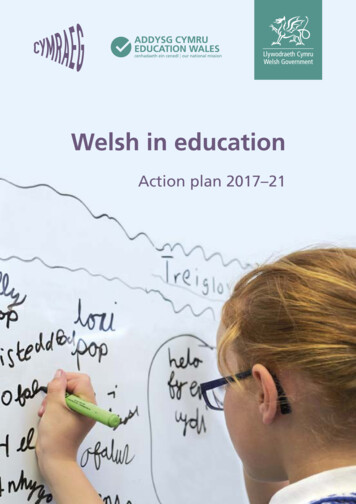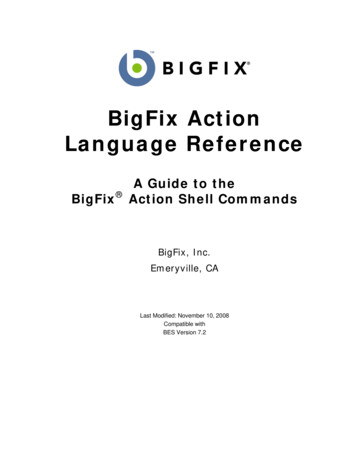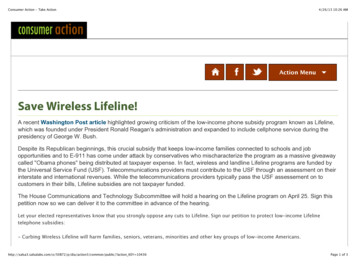
Transcription
Welsh in educationAction plan 2017–21
Welsh in education: Action plan 2017–21AudienceThe school workforce, and those in other settings delivering the Foundation Phase;parents and carers; government and national partners, including regional consortia,local authorities, governing bodies, workforce unions and diocesan authorities;organisations working to promote the use of Welsh; organisations working withfamilies, children and young people; and other interested parties.OverviewThe purpose of this action plan is to set out our direction for the development ofWelsh-medium and Welsh language education over the next four years, in line withthe vision of Cymraeg 2050: A million Welsh speakers and Education in Wales: Ournational mission, Action plan 2017–21. This document gathers together actionsthat are initiated by other Welsh Government publications or those of our deliverypartners.Action requiredInterested parties to note the content of this action plan for 2017–21, and actaccordingly.Further informationEnquiries about this document should be directed to:The Education DirectorateWelsh GovernmentCathays ParkCardiffCF10 3NQe-mail: WelshEducation@gov.walesAdditional copiesThis document can be accessed from the Welsh Government’s website at gov.walesRelated documentsProsperity for All: the national strategy (2017); Education in Wales: Our nationalmission, Action plan 2017–21 (2017); Cymraeg 2050: A million Welsh speakers (2017);Cymraeg 2050: A million Welsh speakers, Work programme 2017–21 (2017); TakingWales Forward 2016–2021 (2016); A curriculum for Wales – a curriculum for life(2015); Qualified for life: An education improvement plan for 3 to 19-year-olds inWales (2014); Successful Futures: Independent Review of Curriculum and AssessmentArrangements in Wales (2015); One language for all: Review of Welsh secondlanguage at Key Stages 3 and 4 (2013); Welsh-medium Education Strategy (2010);Evaluation of the Welsh-medium Education Strategy (2016); Welsh-medium EducationStrategy: next steps (2016)Mae’r ddogfen yma hefyd ar gael yn Gymraeg.This document is also available in Welsh. Crown copyright December 2017WG33270Digital ISBN 978 1 78859 814 5
ContentsMinisterial foreword2Introduction4Background6Strategic context6Welsh in the education system in 20177VisionGuiding principles1414Roles18Objectives and key actions20Curriculum, assessment and pedagogy20Enrichment and experiences in Welsh22Workforce planning, professional learning and leadership24Planning Welsh-medium education28Excellence, equity and well-being30Welsh in education timeline34Communication and engagement36Evaluation and accountability framework for improvement38Targets and indicators40Next steps45Ministerial foreword
2Welsh in education: Action plan 2017–21Ministerial foreword“Our national mission ofeducation reform seeks toraise standards, reduce theattainment gap and deliver aneducation system that enjoyspublic confidence and is a sourceof national pride.The Welsh language is integralto those reforms, as it is to theGovernment-wide objectives ofbuilding resilient communities,culture and language, andpromoting and protecting Wales’place in the world.As Ministers in the Welsh Governmentwith responsibility for Welsh-mediumand Welsh language education,we recognise our role in buildingand further ensuring support for thiscontinued development and growth.Quite simply, all our young people,from all backgrounds, should comeout of the education system readyand proud to use the language inall contexts. It is a matter of equity,and we as Ministers and as WelshGovernment must set the directionand provide leadership.Our own different family and personalbackgrounds strengthen our sharedunderstanding that everyone has a partto play as we move forward to deliverthis action plan with confidence.We know that the developmentof Welsh-medium educationover the last half a century hasbeen extraordinary, particularly inattracting parents/carers and learnersfrom both Welsh-speaking andnon-Welsh-speaking backgrounds.However, we also know that theteaching and learning of Welsh inEnglish-medium settings is inconsistentand too often leads to low attainment.Tackling this challenge, while alsobuilding on success, requires a nationalvision and action plan, in line withCymraeg 2050: A million Welshspeakers (2017) and Education inWales: Our national mission, Actionplan 2017–21 (2017).It is an exciting period for educationin Wales, and we have the opportunityto ensure that the Welsh language iscentral to our ambitious and essentialreforms.From the preparation of the newcurriculum to the professionaldevelopment of the educationworkforce and the reform of how wesupport our learners with additionallearning needs, ensuring that theWelsh language is considered at theheart of these will be a key priority.
3Welsh in education: Action plan 2017–21We are not starting from nothing,indeed we have much of which we canbe proud. But we will need to raise ourexpectations, fully commit to marryingequity with excellence and work acrossour education system to deliver on ourshared ambitions.This action plan for Welsh in educationsets the vision and direction so that weensure all leaners develop their Welshlanguage skills and use the languagewith confidence, through our nationalmission of education reform.Kirsty Williams AMCabinet Secretary for EducationEluned Morgan AMMinister for Welsh Languageand Lifelong Learning
4Welsh in education: Action plan 2017–21IntroductionThe purpose of Welsh in education:Action plan 2017–21 is to set outour direction for the developmentof compulsory Welsh-medium andWelsh language education over thenext four years, in line with the visionof Cymraeg 2050: A million Welsh1speakers (2017) and Education inWales: Our national mission, Action2plan 2017–21 (2017). We recognisethe important part that the earlyyears sector plays in the developmentof children’s Welsh language skills.We also acknowledge the needto ensure linguistic progressioninto further and higher education.However, the detail of this action planis focussed on compulsory provision.1Successive governments haverecognised the importance ofthe Welsh language and the rolethat the education system playsin creating and nurturing Welshspeakers. We published our first3Welsh-medium Education Strategyfor the development of Welsh-mediumeducation in 2010, which set out thevision for an education and trainingsystem to enable people of all agesto be able to develop their Welshlanguage skills. egy/?skip 1&lang licies/education-in-wales/?lang ediumstrategyen.pdf
5Welsh in education: Action plan 2017–21In 2016, we published an interimpolicy statement, Welsh-medium4Education Strategy: next steps(2016), outlining the priorities for thedevelopment of Welsh-medium andWelsh language education during2016–17, while a long-term policy forthe language was developed.This is not the beginning of thejourney; solid foundations havealready been laid. However, as theeducation system embarks onwide-ranging reforms, it providesthe best opportunity to ensure thatthe Welsh language is at the heartof developments.The Evaluation of the Welsh-medium5Education Strategy , publishedin 2016, showed that there wassupport for the vision and goals ofthe strategy among officials (nationaland local) who were responsible forits delivery, and among stakeholdersand practitioners. The fact that anational vision for Welsh-mediumand Welsh language education hadbeen formalised and published hasbeen helpful for some organisations45and individuals in planning to supportWelsh-medium education. However,the evidence also suggested that theWelsh-medium Education Strategy’svision was not rooted in a consistentway across all implementationpartners and across different tiersof the education system, from theWelsh Government to local authoritiesand providers.We want to ensure that there iswidespread support for our visionfor the continued development andgrowth of Welsh-medium and Welshlanguage education. We soughtthe advice and opinions of ourkey partners and stakeholders indeveloping this action plan; we hopenow that each will play their part inits delivery.There are challenges ahead but overthe next four years our main aim is toensure that the required leadership,capacity and infrastructure to deliverthe changes are embedded in orderto move forward with this importantwork for our future esearch/welsh-medium-education-strategy/?lang en
6Welsh in education: Action plan 2017–21BackgroundStrategic contextThe Well-being of Future Generations(Wales) Act 2015 aims to ensurethat public bodies think aboutlong-term strategy and planning.One of the seven goals is a Wales ofvibrant culture and thriving Welshlanguage, and one of the indicatorsis the percentage of people who canspeak Welsh.As one of the key public bodies inWales, we as Welsh Governmentare required to plan for the longterm. Taking Wales Forward62016–21 (2016), our programme forgovernment, notes that we will ‘worktowards one million people speakingthe Welsh language by 2050’. It alsocommits us to ‘reshape Welsh teachingin our schools to enable young peopleto utilise their Welsh language skillsin wider society’. Prosperity for All:7the national strategy , publishedin September 2017, places the keycommitments of the programme forgovernment in a longer term contextand how they fit with the work of thewider Welsh public service. Ensuringthat all learners will be able to usethe Welsh language when they leaveschool, and that we have a sufficientsupply of teachers to work through themedium of Welsh are long-term67commitments, which will requirestrategic planning with our key deliverypartners.Cymraeg 2050: A million Welshspeakers was published in July 2017,and sets out the long-term vision forthe Welsh language. Increasing thenumber of Welsh speakers is oneof the three key themes, and thefollowing key transformationalchanges will be required within theeducation sector in order to achievethe vision. Increase the proportion of eachschool year group receivingWelsh-medium education from22 per cent (based on 7,700seven-year-old learners in 2015/16)to 30 per cent (about 10,500 ineach year group) by 2031, and then40 per cent (about 14,000 in eachyear group) by 2050. Transform how we teach Welsh toall learners in order that by 2050 atleast 70 per cent of those learnersreport that they can speak Welshby the time they leave school. Increase the number of primaryteachers who can teach in Welshfrom 2,900 to 3,900 by 2031and 5,200 by 2050; increase thenumber of secondary teacherswho can teach Welsh from 500to 900 by 2031 and 1,200 by2050; and increase the number erity-for-all-en.pdf
7Welsh in education: Action plan 2017–21secondary teachers who can teachthrough the medium of Welsh from1,800 to 3,200 by 2031 and 4,200by 2050.Education in Wales: Our nationalmission, Action plan 2017–21,which was published in September2017, sets out the actions to be takento implement wide-ranging reformsto the education system in Wales.The aim is to ensure that all learnersbenefit from a world-class curriculumand that they enjoy learning andteaching that inspires them to succeedin an effectively led, collaborativeand innovative education community.Developing Welsh-medium provisionand improving the teaching andlearning of Welsh for all learners areat the heart of these reforms.Welsh in the educationsystem in 2017The Cymraeg 2050 Strategyacknowledges that the educationsector has a key contribution to makein order to achieve our vision of amillion Welsh speakers. As previouslystated, we are not starting fromnothing; we are building on a solidfoundation of Welsh-medium andWelsh language teaching and learningthat developed during the second halfof the twentieth century.Since the publication of theWelsh-medium Education Strategy in2010, we have moved forward with anumber of developments to increaseWelsh-medium education, andimprove the Welsh language skills ofour learners.One of the main aims of theWelsh-medium Education Strategywas to improve the planning ofWelsh-medium education. The SchoolStandards and Organisation (Wales)Act 2013 introduced a requirementfor local authorities to prepare Welshin Education Strategic Plans (WESPs)setting out how they will improvethe planning of education throughthe medium of Welsh including forlearners with additional learningneeds (ALN). Since the first WESPswere developed in 2014, there havebeen several independent reviews ofthem and the associated processes.The evaluation of the Welsh-mediumEducation Strategy that took place in2016 found that placing the WESPson a statutory basis had provided localauthorities with a more consistentand structured framework forplanning Welsh-medium provision.However, the evaluation also indicatedthat planning processes were notalways timely and effective, andthat they were dependent on theapproach adopted by key individuals.The evidence also provides a mixedpicture in relation to changes toWelsh-medium provision for learnerswith ALN. While there are someexamples where specialised supporthas been developed, with some localauthorities planning ahead in orderto offer specialist Welsh-mediumprovision, in other areas there wereexamples of a lack of capacity tosupport learners with ALN.
8Welsh in education: Action plan 2017–21The most recent review of the WESPswas undertaken by Aled Roberts.Rapid review of the Welsh in Education8Strategic Plans – 2017–20 waspublished in August 2017. The rapidreview found that although themajority of stakeholders recognisethat the education system plays a keyrole in creating the Welsh speakers ofthe future, the draft 2017–20 WESPssubmitted to the Welsh Governmentin December 2016 lacked the ambitionneeded to achieve the vision set outin the Cymraeg 2050 Strategy. As wellas providing a review of each localauthority’s WESP, Aled Roberts alsomade 18 recommendations whichincluded: establishing a board to discuss andevaluate the necessary changesneeded in terms of the legislationand regulations reviewing the timeframe of theWESPs to coincide with WelshGovernment’s capital schemes strengthening the strategicrelationship between localauthorities and Mudiad Meithrinto ensure growth at localauthority level urgent planning and action toincrease the number of teacherstrained to teach through themedium of Welsh.8Today, there are 420 primary schoolsdelivering Welsh-medium education toalmost 67,000 learners across Wales,and 49 secondary schools deliveringWelsh-medium education to almost35,000 learners. The challenging targetset in the Cymraeg 2050 Strategy willrequire us to work closely with earlyyears providers and local authoritiesto improve long-term planning forWelsh-medium school places andensure that there are opportunitiesfor learners to access Welsh-mediumeducation at various points andcontinue to learn through the mediumof Welsh post-16.Another focus of the Welsh-mediumEducation Strategy was to supportlearners from all linguistic backgroundsto develop their Welsh language skills.Welsh-medium schools generallydeliver the majority of the curriculumthrough the medium of Welsh, andlearners are immersed in the languagefrom an early age. Bilingual schoolscan refer to a wide range of teachingand learning settings which includevarying amounts of Welsh languagein the delivery. English-mediumschools generally only deliver Welshas a subject with the remainder ofcurricular time delivered throughthe medium of English. As a result,learners’ acquisition of Welsh will varydepending on the nature of provision. view-of-wesp-en.pdf
9Welsh in education: Action plan 2017–21
10Welsh in education: Action plan 2017–21The evaluation of the Welsh-mediumEducation Strategy in 2016 notedthat the percentage of learnersachieving the expected level in Welshat Key Stages 2 and 3 had increasedsince 2010. The national emphasison the National Literacy Frameworkand Numeracy (LNF) and the focus onraising standards more generally werefelt by respondents to have drivenattainment and standards in Welsh.However, as the evaluation of theWelsh-medium Education Strategyindicated, the evidence regardingstandards in Welsh second languagepaints a mixed picture. Estyn annualreports have been critical of standardsin Welsh second language at KeyStage 2 for a number of years,although standards at Key Stage 3have shown some improvement inrecent years. An independent reviewof Welsh second language in 2013,One language for all: Review of Welshsecond language at Key Stages 3 and94, Report and recommendations ,concluded that ‘it is the eleventh hourfor Welsh second language’. One ofthe recommendations of the reviewwas that Welsh Government shouldrevise the curriculum to include ‘onecontinuum of learning for Welsh withclear expectations for pupils learningWelsh in English-medium, bilingualand Welsh-medium settings’.In 2014 we commissioned afundamental review of curriculum andassessment arrangements in Wales.Successful Futures: Independent9Review of Curriculum and Assessment10Arrangements in Wales , publishedin February 2015, concluded thatWelsh should remain compulsory upto the age of 16 and that there shouldbe a ‘renewed focus in schools onlearning Welsh primarily as a meansof communication’. We subsequentlyaccepted the recommendations of thereview and agreed that a continuumof learning Welsh would be developedas part of the new curriculum andassessment arrangements for Wales.This continuum will provide the basisfor teaching and learning Welsh andother languages in the future.Developing the Welsh language skillsof our practitioners and capacity toteach through the medium of Welshis essential to enable the continuedgrowth of the Welsh-medium sector,and to improve the teaching andlearning of Welsh as a subject.In recent years, the focus has beenon ensuring that the workforce hashigh-level Welsh language skills tobe able to deliver Welsh as a subjectwithin the curriculum. Training hasmainly been delivered via the regionalconsortia through the EducationImprovement Grant (EIG), and throughthe Welsh language Sabbatical Schemefor practitioners.Published in 2014, Evaluation of theWelsh-medium Education Strategy:Review of the Welsh-languageSabbatical Scheme for educationalpractitioners: participant experiences112011-2012 found a positive ns/wagreviews/one-lanuage-for-all/?lang sful-futures-en.pdf11 cation-strategy/?skip 1&lang en10
11Welsh in education: Action plan 2017–21of the Sabbatical Scheme amongparticipants and stakeholders.Participants reported that theirconfidence in using their Welshlanguage skills had increased, and allthose who contributed to the reviewhad positive views about the qualityand nature of the courses provided.The review also identified the need toplan and deliver the programme in amore strategic and targeted manner,and to address the post-course supportprovided for participants. However,the main message from all those whocontributed to the review (participants,local authorities and senior managers)was that the Sabbatical Scheme isa valuable scheme and that there isa continuing need for such courses.It appears that this stems from aperception among senior managers,participants and local authority officersthat a lack of Welsh language skillscontinues to be an issue requiringattention.The supply of teachers for theWelsh-medium sector continues to bea cause for concern. The evaluation ofthe Welsh-medium Education Strategyfound that there was no evidence toshow that the strategy had made asignificant contribution to the criticalmass of the Welsh-medium educationworkforce. However, representativesof national education and teacherorganisations that contributed tothe evaluation acknowledged theimportance of the financial incentivesto support future teachers to teachthrough the medium of Welsh.1213In 2015, Professor John Furlongpresented his options for the future ofinitial teacher education (ITE) in Walesin Teaching tomorrow’s teachers:Options for the future of initial teacher12training in Wales . The changes to ITEprovide an opportunity to review thecurrent programmes and incentiveswhich support the development ofWelsh language and Welsh-mediumteachers to ensure that we can buildcapacity in the teaching workforce forthe future.The new Professional Standards for13Teaching and Leadership , publishedin September 2017, acknowledge thatall practitioners need to continuallydevelop their Welsh language skills andthat all education leaders consistentlyemphasise the promotion of Welshculture and language within the ethosof the school and as they develop theschool as a learning organisation.The planning of Welsh-mediumeducation, the teaching and learningof Welsh and through the medium ofWelsh, and the development of theworkforce made up the key strands ofthe Welsh-medium Education Strategy.However, the strategy also recognisedthat the development of Welsh in oureducation system would also need tobe supported by the development ofWelsh language teaching and learningresources, and all our learners needto recognise that the Welsh languageextends beyond the classroom into thecommunity and the lang en
12Welsh in education: Action plan 2017–21The Evaluation of the Welsh-mediumEducation Strategy: Review ofthe Use and Quality of ResourcesCommissioned by the WelshGovernment’s Welsh in Education14Unit (2014) found that although ourresources commissioning programmemakes a valuable contribution,the limited range of resources in anumber of areas remains problematicfor headteachers and practitioners,and practitioners in the Welsh-mediumsector still face an additional workloadin preparing Welsh-medium resourcesto fill gaps.Education and training alone cannotguarantee that speakers becomefluent in Welsh, or choose to use thelanguage in their everyday lives.14However, as noted in the evaluation ofthe Welsh-medium Education Strategy,it is clear that the education systemhas a key influence on young people’spotential to use the Welsh languagein their everyday lives. Over the pasttwo years working with regionalconsortia, we have built on the WelshLanguage Charter, developed byGwynedd Council, and the SupportingLanguage Practices project to providea whole-school approach to expandingchildren and young people’s use ofthe language. With children andyoung people at the heart of process,schools develop their individual plansin partnership with the wider schoolcommunity. This programme willprovide a foundation for how wemove forward to promote and supportchildren and young people’s use of thelanguage. s-en.pdf
13Welsh in education: Action plan 2017–21It is important to celebrate thepositive steps that have been takenover the past seven years to supportthe development of Welsh languageand Welsh-medium education.To summarise, some of the keydevelopments since 2010 include: supporting student teachers toraise their confidence and languageskills to teach through the mediumof Welsh and working with theColeg Cymraeg Cenedlaethol tointroduce the Welsh Language SkillsCertificate placing local authority WESPs ona statutory basis undertaking research to gain a morein-depth understanding of howimmersion education is delivered expanding the Welsh-languageSabbatical Scheme for practitionersto include school support staff andcourses on various levels commissioning approximately435 projects to developquality-assured teaching andlearning resources for 38 subjectareas providing funding to localauthorities and regional consortiato raise standards in the teachingand learning of Welsh and throughthe medium of Welsh expanding our support to promoteand increase children and youngpeople’s use of Welsh withinthe school and in social contextsthrough the Welsh LanguageCharter, developed by GwyneddCouncil, and projects to supportsecondary schools, in partnershipwith the regional consortia andthe Urdd.We have learnt lessons along theway, and we will continue to ensurethat our developments are basedon evidence and lead to changes atall levels of the system as we moveforward.
14Welsh in education: Action plan 2017–21VisionOur vision is to enable all learners todevelop their Welsh language skillsand to use the language confidentlyin everyday life.In order to achieve this vision, we mustensure that all learners benefit froma world-class curriculum and thatthey enjoy learning and teachingthat inspires them to succeed in astrategically planned, effectively led,collaborative and innovative educationcommunity.Guiding principlesIn order to achieve the vision,we will require several phases ofimplementation to build sustainableprovision for our future generations.The following principles are intendedto foster a common understandingof the role of teaching and learningWelsh, and through the medium ofWelsh, in all schools in Wales andprovide a foundation for future policydevelopments.1. Teaching and learning Welshis recognised and valued asan integral component ofWales’ education system fromthe early years through topost-compulsory provision.Welsh was included in the nationalcurriculum following the EducationReform Act 1988, and became acompulsory subject for all learnersin Wales in Key Stages 1, 2 and 3 in1990. From September 1999 onwardsWelsh became compulsory for alllearners across Wales at Key Stage 4.This will not change and, in future,increasing value will be placed onWelsh as a subject and as a mediumfor teaching and learning. A newcurriculum encompassing a frameworkfor developing language skills along acontinuum, greater teacher capacityand research into effective pedagogieswill inform teaching and learning.Communication with parents andcarers about the benefits of learningthe language and how they cansupport their children will be essential.2. T hrough the new curriculumall children and young peoplein Wales will be ambitiousand capable learners who cancommunicate effectively indifferent forms and settings,and through digital platforms,using both Welsh and English.In support of one of the four corepurposes of the curriculum in Wales,the aim is to ensure that all learnershave appropriate pathways forlearning Welsh to enable them tobecome confident enough to use thelanguage in everyday life. They will begiven opportunities to use Welsh inthe curriculum, beyond the classroomand on digital platforms so thatthey appreciate its usefulness tocommunication in a bilingual Wales.
15Welsh in education: Action plan 2017–213. Learning through the mediumof Welsh can enhance Welshlanguage learning and enablechildren and young people todevelop their confidence to usethe language in a wide rangeof contexts.Welsh-medium education providesopportunities for learners to developtheir proficiency in Welsh, as well as inEnglish. Facilitating the use of Welsh –both across the curriculum and inextracurricular activities – with plannedlinguistic progression through everyphase of education from the earlyyears, will offer opportunities for allchildren and young people to becomemore fully bilingual.4. All practitioners and leaders areengaged in developing theirWelsh language skills and alsotheir wider understanding of theWelsh language in its historicaland cultural context.It is essential that all practitioners andleaders have the required skills andknowledge to develop our childrenand young people’s appreciation ofthe Welsh language, its literatureand history, and also its relevance totheir everyday life in contemporaryWales and in future employment.Practitioners and leaders will havemore opportunities to improve theirown knowledge and understanding,and to share this with their learners.5. R esearch into languageacquisition, bilingualism andeffective Welsh languageteaching informs teachingand learning.In future, curriculum planning andpedagogy will be more informedby research and evidence abouteffective language teaching andlearning, including approaches tolanguage immersion, and the role ofbilingualism in supporting multiliteracyand learners’ linguistic and cognitivedevelopment.6. I n developing their skills inWelsh and English, childrenand young people can acquirea foundation for learningadditional languages, readyto be citizens of Wales andthe world.Enabling children and young people todevelop their proficiency in Welsh andEnglish can provide a basis for learningadditional languages and for learningabout other cultures. Including alllanguages under one Area of Learningand Experience (AoLE) within the newcurriculum provides an opportunity tomake connections between languagesand enable learners to draw on all theirlinguistic resources to their maximumpotential.
16Welsh in education: Action plan 2017–21
17Welsh in education: Action plan 2017–21
18Welsh in education: Action plan 2017–21RolesAs outlined in Education in Wales:Our national mission, Action plan2017–21, to deliver our reformsacross the entire system we will needa bold commitment to collaboration.This will include Welsh Government,the teaching profession and the widereducation workforce. Successfulimplementation will require effectiveand honest engagement between allfacets of the education system. We arecommitted to providing the conditi
following key transformational changes will be required within the education sector in order to achieve the vision. Increase the proportion of each school year group receiving Welsh-medium education from 22 per cent (based on 7,700 seven-year-old learners in 2015/16) to 30 per










